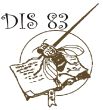
Ui-Tei, Kumiko, and Yuhei Miyata. 2000. Cell lines derived from Drosophila larval central nervous system and their practical applications. Dros. Inf. Serv. 83: 188-189.
|
|
Ui-Tei, Kumiko, and Yuhei Miyata. 2000. Cell lines derived from Drosophila larval central nervous system and their practical applications. Dros. Inf. Serv. 83: 188-189. |
|||
|
|
||||
Cell lines derived from Drosophila larval central nervous system and their
practical applications.
Ui-Tei, Kumiko, and
Yuhei Miyata.
Department of Pharmacology, Nippon Medical School, 1-1-5 Sendagi, Bunkyo-ku,
Tokyo 113-8602, Japan.
The central nervous system (CNS) is composed of a large heterogeneous
population of cells. This complexity
makes it difficult to dissect neuronal functions at a cellular level. One way to resolve this problem is to
use cell lines consisting of homogenous cells originated from the nervous
system. To this end, we have
succeeded in establishing cell lines from the CNS of Drosophila 3rd instar larva: 8 continuous
cell lines, designated as ML-DmBG1~8, and clonal lines from 3 of them (Table
1; Ui et al., 1994a). Here, we introduce these cell lines and some of the practical
applications.
All parental cell lines (ML-DmBG1~8) and 10 colonial clones originating
from ML-DmBG2 (ML-DmBG2-c1~10) reacted to the antibody to horseradish peroxidase
(HRP) (Ui et al.,
1994a). HRP is a neuronal marker
in insects. Thus, it is likely
that these clonal cells are neuronal.
Therefore, we analyzed neurotransmitters or their candidates in 10
clonal cell lines from ML-DmBG2. Acetylcholine
(ACh), a major neurotransmitter in Drosophila, was found in 7 out of 10 clones, and substance
P and proctolin were detected in 7 and 8 out of 10, respectively (Ui-Tei et
al., 1994b, 1995).
Although catecholamine(CA)s, their metabolites, other amines (serotonin,
octopamine), GABA and taurine were not detected in any clones, L-DOPA, a precursor
of CAs, and somatostatin were expressed in all clones. Thus, these cell lines are also neuron-like with respect to
chemical phenotypes. Thus, we
assumed to be and used as neuronal model cells. We describe some biochemical studies using these cell lines
below.
ML-DmBG2-c2 cells, which contains the highest amount of ACh among the
10 clonal lines, were used for investigating the mechanism of apoptosis (Ui-Tei,
et al., 1996; Nagano, et al.,
1998; Ui-Tei, et al., 2000). Apoptosis
is defined by its morphological feature and internucleosomal DNA fragmentation
in vertebrates. However, a similar
type of cell death was not reported biochemically in Drosophila. We showed for the first time that cell
death characteristic for apoptosis also occurs in Drosophila cells (Ui-Tei, et al.,
1996). The cell death was induced
in the clonal cells by the treatment with a calcium ionophore, and the characteristic
morphological changes, such as nucleus condensation and membrane-bound apoptotic
bodies, were observed. In this cell death, DNA fragmentation of nucleosomal size was
clearly detected. Therefore,
a typical apoptosis is shown to occur also in Drosophila cells. Furthermore, apoptosis could be induced
by other chemicals in the cells. Based
on these results, we concluded that the apoptotic pathway is not unique in
the clonal cells (Ui-Tei et al., 2000).
Although many of the established Drosophila
cell lines lack adhesive properties, some of the CNS-derived cell lines such
as ML-DmBG1 and 2 have cell-cell and cell-substratum adhesive properties. Using ML-DmBG1 cells, Hirano et al. (1991) revealed the first evidence that
Drosophila integrins can function as receptors for
cell-substratum adhesion recognizing vitronectin. ML-DmBG2-c6 among 20 lines screened showed the strongest adhesion
activity when purified Drosophila laminin was used as substrate (Takagi et al., 1998). Using this line, Takagi et al. showed that laminin-mediated cell spreading
caused integrin clustering which colocalized with intracellular signaling
molecules such as p21-activated protein kinase (PAK) and Enabled (Ena: a substrate
for Abelson tyrosine kinase) (Takagi et al.,
1999). Furthermore, laminin is
shown to trigger tyrosine - phosphoryla-tion of Ena and other unidentified
proteins (Takagi et al.,
2000).
Protein synthe-sis patterns of three clones were analyzed using high
resolution two-dimensional gel electrophoresis analysis by Santaren et
al. (1996).

Drosophila is a valuable insect for studying biological
mechanism because of the extensive knowledge of its genetics. However, its small body size makes biochemical
and physiological approaches at the cellular level relatively difficult.
Thus, the cell lines which offer large amounts for biochemical study
are useful.
References: Hirano, S., K. Ui, T. Miyake, T. Uemura,
and M. Takeichi 1991, Development 113:1007-1016; Nagano, M., H. Suzuki, K. Ui-Tei, S. Sato,
T. Miyake, and Y. Miyata 1998, Neurosci. Res.31:113-121; Santaren, J. F., 1996, In Vitro Cell.
Dev. Biol.Anim. 32: 434-440; Takagi,
Y., K. Ui-Tei, T. Miyake, and S. Hirohashi 1998, Neurosci. Lett. 244: 149-152;
Takagi, Y., K. Ui-Tei, and S. Hirohashi 1999, In Vitro Cell. Dev. Biol.
Anim. 35: 549-552; Takagi, Y.,
K. Ui-Tei, and S. Hirohashi 2000, Biochem. Biophysic. Res. Commun. 270: 482-487; Ui, K., S. Nishihara, M. Sakuma, S. Togashi,
R. Ueda, Y. Miyata, and T. Miyake 1994a, In Vitro Cell. Dev. Biol. 30A: 209-216;
Ui-Tei, K., S. Nishihara, M. Sakuma, K. Matsuda, T. Miyake, and Y.
Miyata 1994b, Neurosci. Lett. 174: 85-88;
Ui-Tei, K., M. Sakuma, Y. Watanabe, T. Miyake, and Y. Miyata 1995,
Neurosci. Lett. 195: 187-190; Ui-Tei, K., S. Sato, T. Miyake, and Y.
Miyata 1996, Neurosci. Lett. 203: 191-194; Ui-Tei, K., M. Nagano, S. Sato, and Y. Miyata 2000, Apoptosis
5: 133-140.